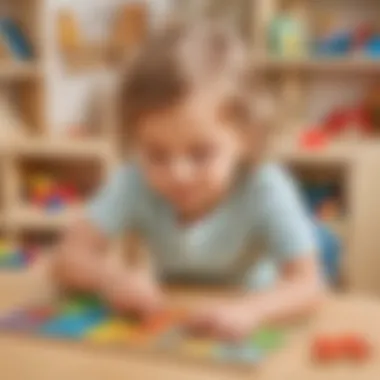Unveiling the Ultimate Cognitive Development Blueprint for Preschoolers


Creative Activities
In this section, we will explore various creative activities designed to stimulate cognitive development in preschoolers. Craft ideas will be shared, providing children with hands-on experiences to enhance their cognitive skills. Step-by-step guides for each activity will be included to ensure easy replication by young learners. The educational value of these activities will be discussed, emphasizing how each craft contributes to the overall cognitive growth of children.
Fun Quizzes
Moving on to the fun quizzes section, we will delve into the topics covered in quizzes available on Elem Fun. Different question types will be explained to showcase how they engage children and promote critical thinking. The quizzes serve as a valuable tool for knowledge reinforcement, strengthening the understanding of various concepts in a playful and interactive manner.
Fact-Based Articles
Lastly, we will explore fact-based articles covering a diverse range of engaging topics. These articles are crafted to present information in an accessible and easy-to-understand format for preschoolers. Links to additional resources will be provided for those interested in further exploration, offering an enriching learning experience for young minds.
Understanding Cognitive Development in Preschoolers
In the realm of preschool education, understanding cognitive development holds paramount importance. It serves as the foundational framework for crafting effective lesson plans tailored to the unique needs of young learners. By comprehensively delving into the intricacies of cognitive growth at this early stage, educators can strategically design activities that promote critical thinking, problem-solving skills, and overall cognitive advancement in preschoolers. This section sheds light on key concepts that form the basis of cognitive development and explores factors that influence young minds' learning processes.
Key Concepts in Cognitive Development
Theories of Cognitive Development
The theories of cognitive development play a pivotal role in shaping educational practices for preschoolers. Understanding prominent theories such as Piaget's stages of cognitive development or Vygotsky's sociocultural theory provides educators with valuable insights into how children perceive and process information. By integrating these theoretical frameworks into lesson plans, teachers can create activities that align with the cognitive readiness and developmental milestones of preschoolers, fostering enhanced learning outcomes.
Cognitive Milestones in Preschoolers


Cognitive milestones in preschoolers mark significant achievements in their intellectual growth and overall cognitive capabilities. These milestones encompass various aspects, including language development, memory retention, problem-solving skills, and attention span. Recognizing and addressing these milestones in educational settings enables educators to tailor their approaches to meet children's evolving cognitive needs effectively. By leveraging cognitive milestones as a guiding benchmark, teachers can adapt teaching strategies to optimize cognitive development in preschoolers.
Factors Influencing Cognitive Growth
Environmental Stimuli
Environmental stimuli play a crucial role in shaping preschoolers' cognitive growth and learning experiences. The sensory-rich environment provided in early childhood settings enhances children's exploration, curiosity, and cognitive engagement. By incorporating stimulating materials, varying textures, and diverse sensory experiences, educators can create a conducive learning environment that promotes cognitive development and ignites young learners' intellectual curiosity.
Social Interactions
Social interactions serve as a catalyst for cognitive growth in preschoolers. Peer-to-peer interactions, group activities, and collaborative learning experiences offer valuable opportunities for children to develop social-emotional skills, communication abilities, and problem-solving strategies. By fostering positive social interactions within the classroom setting, educators not only nurture children's cognitive development but also cultivate essential life skills that are fundamental to their overall growth and well-being.
Designing a Holistic Cognitive Lesson Plan
In the realm of preschool education, the design of a holistic cognitive lesson plan stands as a critical pillar in shaping young minds. This section delves into the intricacies of crafting a well-rounded learning program that caters to the unique cognitive development needs of preschoolers. By emphasizing the importance of a holistic approach, educators can optimize the learning potential of children in foundational stages. The significance of this topic within the broader context of the article lies in its potential to foster critical thinking, problem-solving skills, and overall cognitive development in a comprehensive yet engaging manner. By incorporating diverse elements into the lesson plan, educators can create a stimulating environment that nurtures cognitive growth and curiosity among preschoolers.
Setting Learning Objectives
Identifying Core Areas of Focus
Delving into the essence of identifying core areas of focus within a cognitive lesson plan, educators aim to pinpoint the fundamental aspects that warrant emphasis during the preschool learning journey. This strategic approach allows educators to streamline the teaching process towards essential cognitive domains while honing in on key developmental milestones. By aligning learning objectives with these core areas of focus, educators can enhance the relevance and effectiveness of the lesson plan, thus optimizing the cognitive growth potential for preschoolers. The key characteristic of this approach lies in its ability to provide a structured guideline for educators to align their teaching strategies with the developmental needs of young children. While this method offers clear benefits in promoting cognitive development, educators must remain mindful of potential limitations, such as the need for flexibility in accommodating individual differences among preschoolers.
Aligning Objectives with Developmental Stages
Aligning learning objectives with developmental stages forms a crucial aspect of designing a cognitive lesson plan tailored for preschoolers. This alignment ensures that educational goals are synchronized with the cognitive abilities and milestones typical for a specific age group. By tailoring objectives to meet developmental milestones, educators can create a scaffolded learning experience that progresses in line with the evolving cognitive capacities of young learners. The strategic advantage of this approach lies in its ability to establish a developmentally appropriate framework that cultivates a deeper understanding of cognitive concepts while promoting optimal learning outcomes. However, it is essential to recognize the potential challenges that may arise, such as the need for educators to adapt teaching strategies to address variations in individual developmental trajectories.


Incorporating Multisensory Activities
Hands-On Experiments
Within the realm of cognitive development, hands-on experiments serve as a powerful tool for engaging preschoolers in interactive learning experiences. These experiments enable children to explore cognitive concepts through tactile exploration, encouraging active participation and deepening understanding. The key characteristic of hands-on experiments lies in their ability to promote experiential learning, allowing children to connect theoretical knowledge with practical applications. By integrating hands-on experiments into the lesson plan, educators can facilitate a kinesthetic approach to learning that caters to diverse learning styles. While hands-on experiments offer numerous advantages in enhancing cognitive development, educators should remain mindful of the resources and supervision required to execute such activities effectively.
Visual and Auditory Stimuli
The integration of visual and auditory stimuli holds immense potential in enriching the cognitive learning experience for preschoolers. Visual aids such as images, charts, and multimedia resources provide valuable support in elucidating abstract concepts and enhancing comprehension. Likewise, auditory stimuli including music, sounds, and storytelling can captivate young minds and stimulate cognitive engagement. The unique feature of visual and auditory stimuli lies in their ability to appeal to different sensory modalities, accommodating varied learning preferences among preschoolers. By incorporating these stimuli into the lesson plan, educators can create a dynamic and immersive learning environment that caters to the holistic development of children. Despite the evident advantages of visual and auditory stimuli, educators must also consider the potential challenges in ensuring the accessibility and appropriateness of such resources within the educational setting.
Promoting Critical Thinking Skills
Problem-Solving Challenges
Engaging preschoolers in problem-solving challenges forms a key strategy in nurturing critical thinking skills within a cognitive lesson plan. These challenges present children with opportunities to apply logical reasoning, creativity, and analytical skills to solve real-life problems. The key characteristic of problem-solving challenges lies in their capacity to promote cognitive agility, resilience, and innovation among young learners. By incorporating a range of problem-solving activities into the lesson plan, educators can encourage children to approach cognitive tasks with curiosity and confidence. While problem-solving challenges offer considerable advantages in developing critical thinking skills, educators must be attuned to the varying levels of complexity suitable for different age groups to ensure optimal learning outcomes.
Encouraging Logical Reasoning
Encouraging preschoolers to engage in logical reasoning activities contributes significantly to their cognitive development journey. By presenting challenges that require logical deduction, sequencing, and pattern recognition, educators can stimulate the innate capacity of children to think critically and systematically. The key characteristic of encouraging logical reasoning lies in its potential to enhance children's analytical skills, decision-making abilities, and cognitive flexibility. This approach underscores the importance of cultivating a structured and coherent thinking process in young learners, laying a strong foundation for future academic and problem-solving endeavors. While encouraging logical reasoning brings substantial benefits to cognitive development, educators should tailor activities to scaffold the complexity of reasoning tasks based on the cognitive abilities and readiness of preschoolers.
Implementing the Lesson Plan
In this section, we will delve into the crucial aspect of implementing the lesson plan designed to maximize cognitive development for preschoolers. Implementing the lesson plan is a meticulously structured process that plays a pivotal role in nurturing young minds. By following a well-thought-out plan, educators can create an environment that fosters cognitive growth and critical thinking skills. This stage is where the theoretical aspects of the lesson plan are put into action, ensuring that preschoolers receive the necessary stimuli for their cognitive development. Implementing the lesson plan involves executing various activities and strategies to create an engaging and educational experience for children.
Creating a Structured Learning Environment


Organizing Learning Stations
Organizing learning stations is a fundamental component of creating a structured learning environment for preschoolers. By dividing the classroom into specific stations focused on different skills or subjects, educators can provide a balanced and comprehensive learning experience. Each station is designed to cater to a particular aspect of cognitive development, such as problem-solving, creativity, or language skills. This approach helps children navigate through different activities independently and fosters autonomy in learning. The key characteristic of organizing learning stations is the systematic arrangement that allows for easy accessibility and smooth transitions between activities. It ensures that each child can engage with diverse learning materials at their own pace, promoting individualized learning experiences. Organizing learning stations is a popular choice for this article as it aligns with the goal of maximizing cognitive development through hands-on and interactive learning.
Utilizing Technology Appropriately
Integrating technology appropriately into the lesson plan is essential for enhancing the learning experience for preschoolers. Technology can offer interactive and engaging opportunities for children to explore new concepts and ideas. When utilized correctly, technology can facilitate multisensory learning experiences that cater to different learning styles. The key characteristic of utilizing technology appropriately is striking a balance between screen time and hands-on activities to ensure a holistic learning approach. It is a beneficial choice for this article as it complements traditional teaching methods and prepares children for the digital age. However, it is important to monitor and regulate technology usage to prevent overreliance and maintain a healthy learning environment. The unique feature of utilizing technology appropriately is its potential to enhance engagement and motivation among preschoolers while facilitating skill development.
Evaluating Progress and Adjusting Strategies
Assessment Methods
Assessment methods play a crucial role in evaluating the progress of preschoolers and determining the effectiveness of the lesson plan. By using various assessment techniques, educators can gauge the development of cognitive skills and identify areas that require further attention. The key characteristic of assessment methods is their ability to provide valuable insights into individual learning outcomes and the overall impact of the lesson plan. They are a beneficial choice for this article as they allow educators to tailor teaching strategies to meet the specific needs of each child. However, it is essential to use a diverse range of assessment methods to capture the multidimensional nature of cognitive development. The unique feature of assessment methods lies in their capacity to support continuous improvement and adaptive teaching practices.
Flexible Teaching Approaches
Adopting flexible teaching approaches is essential for accommodating the diverse learning needs and preferences of preschoolers. By being responsive and adaptable in their teaching methods, educators can create a supportive environment that encourages exploration and experimentation. The key characteristic of flexible teaching approaches is their emphasis on personalized learning experiences that cater to individual strengths and challenges. They are a beneficial choice for this article as they foster a positive and inclusive learning atmosphere where every child can thrive. However, striking a balance between structure and flexibility is crucial to maintain coherence and effectiveness in teaching. The unique feature of flexible teaching approaches is their capacity to promote creativity and critical thinking while adapting to the evolving needs of preschoolers.
Enhancing Parental Involvement and Support
In the domain of maximizing cognitive development in preschoolers, elevating parental involvement and support stands as a pivotal element. Parents play a significant role in complementing the formal education children receive in early childhood settings. Their active participation can greatly amplify the effectiveness of cognitive lesson plans by extending learning beyond the classroom environment. Engaging parents in their children's educational journey fosters a cohesive approach towards enhancing cognitive skills and critical thinking abilities. By forging strong partnerships with parents, educators create a seamless transition between school-based activities and home-based reinforcement.
Communication Strategies with Parents
Sharing Learning Outcomes
Delving into the specifics of sharing learning outcomes with parents unravels a crucial aspect of effective parental engagement. This approach involves transparently communicating the intended learning objectives, key milestones, and progress markers to parents. By keeping parents informed about their child's cognitive development journey, educators empower them to actively contribute to their child's learning experience. This transparent exchange of information cultivates a sense of shared responsibility between teachers and parents, ultimately benefiting the child's overall cognitive growth and skill acquisition. The significant advantage of sharing learning outcomes lies in creating a cohesive educational ecosystem where parents can align their efforts with the school curriculum, thereby fortifying the cognitive development of preschoolers.
Encouraging Home Reinforcement
Encouraging home reinforcement emerges as a strategic method to deepen the impact of cognitive lesson plans beyond the confines of the classroom. This aspect involves suggesting activities and exercises that parents can seamlessly integrate into their daily routine to reinforce the concepts taught in school. By encouraging parents to actively engage in educational practices at home, educators extend the learning process into a familiar and comfortable setting, enhancing retention and application of cognitive skills. The unique feature of encouraging home reinforcement lies in promoting a holistic approach to learning that combines formal education with informal, family-centric activities. While the advantages are evident in strengthening the child's cognitive foundation, potential disadvantages may arise from varying levels of parental involvement or resource availability, emphasizing the need for flexible and adaptable strategies.







